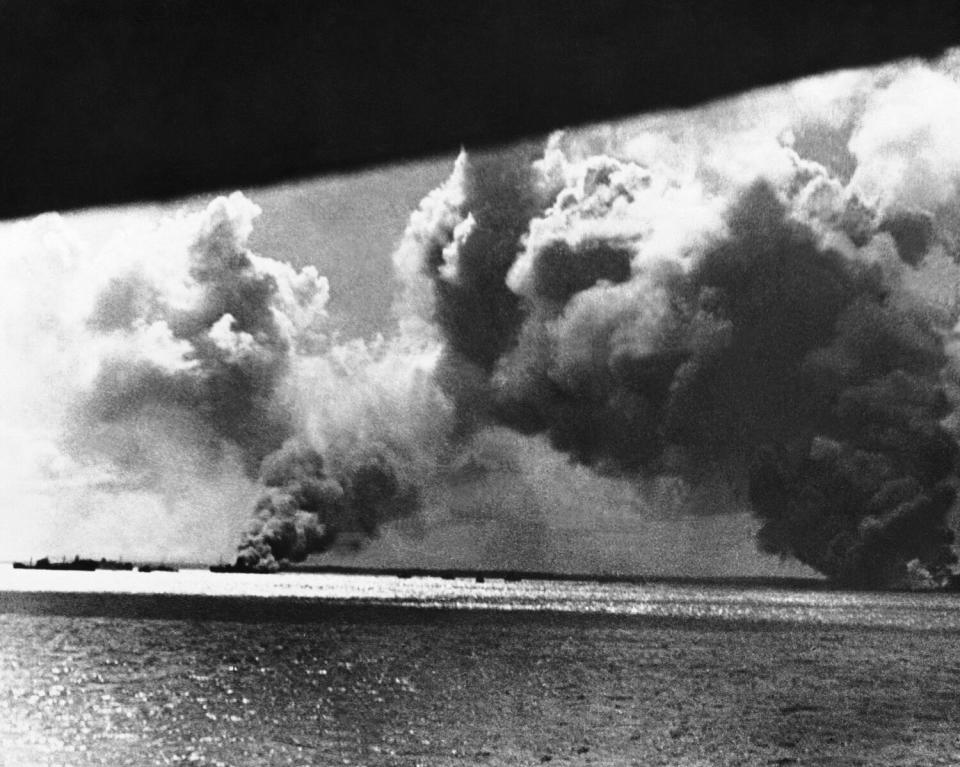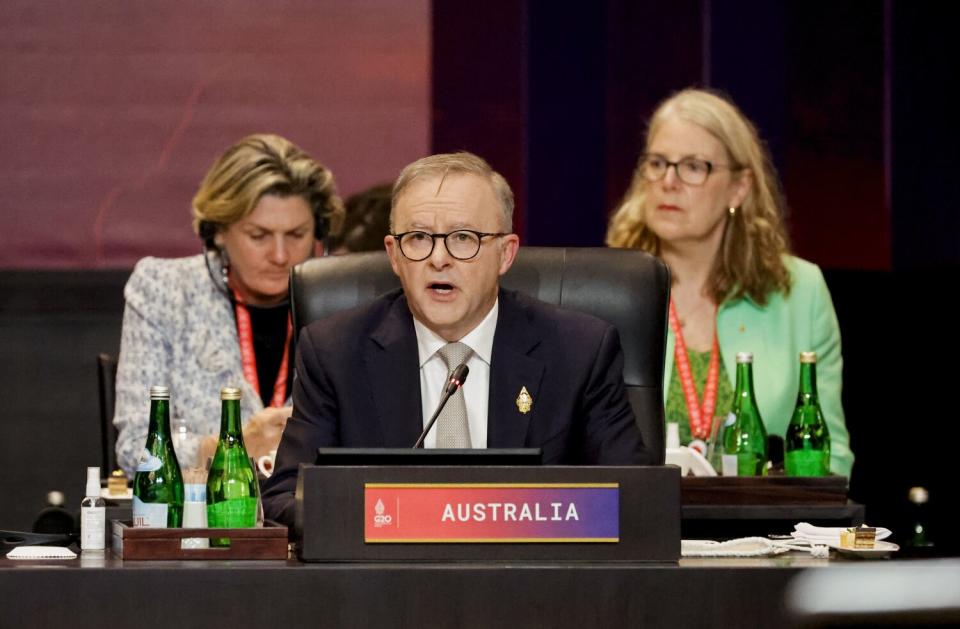The U.S. military has big plans for an Australian port. So does the Chinese firm that controls it
- Oops!Something went wrong.Please try again later.
This port city in hot and humid northern Australia likes to compare itself to Pearl Harbor. Both were bombed by Japanese forces during World War II; the attack on Darwin killed 200 people and flattened the town barely two months after Tokyo’s assault on Hawaii.
Now, 81 years later, Darwin is once again caught up in geopolitical tensions as the U.S. and Australia seek to counter a new threat looming in the Asia-Pacific region. The two countries are beefing up their joint military presence and cooperation here to contain and respond to the danger they perceive from an increasingly aggressive China.
But plans to turn Darwin into a bigger hub for U.S. Marines and Australian troops have refocused attention on an ironic fact: The port is controlled by a Chinese company.
Although it’s not stopping the expansion, the Chinese stake has sparked nervousness in both Washington and Canberra, where Prime Minister Anthony Albanese has promised a new review of the port’s 2015 sale, warning that the company leasing the port is “connected, very directly, with the government of the People’s Republic of China.”

The concerns have also highlighted the tightrope act that is Canberra’s relationship with Beijing. Militarily and politically, Australia and the U.S. are close allies who warn of China’s growing power and influence. Economically, however, China is far and away Australia’s largest trading partner, bigger than the next three — Japan, the U.S. and South Korea — combined, and Albanese’s fledgling government is under pressure to repair ties that have been strained for years.
“This reality is a major motivation for seeking to stabilize relations with Beijing,” says James Laurenceson, director of the Australia-China Relations Institute at the University of Technology Sydney. Australia’s largest bilateral trade surplus is with China, while its largest trade deficit is with the U.S. “This creates political dynamics and public perceptions very different to those in the U.S. around trade with China.”
The 99-year Darwin Port lease granted to Chinese billionaire Ye Cheng’s Landbridge Group for 506 million Australian dollars (about $355 million at current exchange rates) ranks just behind Australia’s strategic alliance with the U.S. as the issue with the most potential to hamper relations with China, according to the institute.
In December, U.S. Defense Secretary Lloyd J. Austin III called China’s actions in the Indo-Pacific a threat to regional peace and stability and announced plans to ramp up the presence of U.S. forces in Darwin.
“We're meeting at a time of tension … especially from Russia's reckless and lawless invasion of Ukraine, as well as from coercive and destabilizing military activities by the People's Republic of China,” Austin said after a meeting with his Australian counterpart, Richard Marles, in Washington. “But the United States and Australia are stepping up to support the rules-based international order.”
The U.S. Marine rotation in Darwin has grown from 200 Marines in 2012 to 2,500 in 2019. The increased U.S. presence would include bomber task forces, fighter jets and other aircraft, and Navy and Army capabilities.
U.S. forces also use Darwin’s harbor services for vessels, equipment, exercises and logistics, and to resupply.
The U.S. is planning to construct an aircraft parking apron at an Australian air base outside Darwin to accommodate six B-52s. It has already begun building a $156-million facility at Darwin Port to store about 80 million gallons of fuel.
For its part, Australia is receiving U.S. help in developing nuclear-powered submarines, a key component of the two countries’ new security pact signed along with Britain in 2021 to deal with a geopolitical picture that Marles said was “as complex and precarious” as any since the end of World War II.

But the global economy is also more complicated and interconnected than ever, which Darwin, the capital of Australia’s Northern Territory, illustrates — and which has led to today’s uncomfortable situation with the port.
Back in 2015, the port needed upgrading. Chinese President Xi Jinping addressed the Australian Parliament that same year, and before it was out, the China-Australia Free Trade Agreement came into effect, granting Australia even greater access to Chinese markets.
Landbridge already successfully operated a port in northern China. In 2014, it bought Australian oil and gas company Westside, its first foray abroad. It emerged from a group of 33 bidders to acquire the Darwin Port lease in 2015.
Then-President Obama was reportedly annoyed that Washington hadn’t been consulted. But, according to media reports, not even Canberra was.
Although the Australian federal government is responsible for defense and security, then-Defense Minister Marise Payne reportedly said she was told only a few hours before it was signed that a Chinese entity got the contract in October 2015. The Northern Territory government retains a 20% stake in the lease.
At the time, Albanese, then part of the political opposition, called the decision “a grave error of judgment.” But no review since has found compelling reasons to overturn the sale.
The port has “a long history of disregard, disrepair and haphazard investment and control by successive governments dating back to the close of World War II,” a 2021 report by the Australian Strategic Policy Institute, or ASPI, said. “Many Canberra policymakers were unconcerned by the 99-year lease of the port to a Chinese-owned company.”
Chinese control may not be an issue in peacetime, but in a time of war the Chinese government would probably pressure Landbridge to reduce access for Australian or U.S. vessels or use the port for intelligence-gathering on Australian and allied naval operations, ASPI analyst Malcolm Davis warned.
The port “will be a growing concern, particularly as Australia begins greater cooperation with both Washington and Tokyo in terms of hosted forces,” Davis said. “It’s not just Australia-China relations at stake.”
Those ties have soured since 2015, over such issues as Canberra’s decision to ban Chinese telecommunications company Huawei from its 5G network and to tighten the rules on acquisition of Australian assets by Chinese firms. Most provocative, in Beijing’s eyes, was Australia’s call for an inquiry into the origin of the coronavirus. The Chinese government imposed $14 billion in trade sanctions in 2021 on Australian beef, wine and other products.
By the time of the May 2022 election that brought Albanese to power, one poll showed 60% of Australians wanting the government to reclaim Darwin Port. In August, Albanese repeated his election pledge for a review and made his allegation that Landbridge was “very directly” connected to China’s communist government.

The company disputes that.
“Landbridge is a privately owned company that is based in China,” said Terry O’Connor, the chief executive of Darwin Port from 2015 to 2019 and now a non-executive director of the board. “The owner is a Chinese national and has multiple business interests across the world. I am unsure on what the comment that the company is directly connected with the People’s Republic of China is based on.”
O’Connor expects the latest government review, like at least two previous ones, to conclude that there’s no issue. Landbridge has invested more than $40 million in the port and isn’t planning to sell back the lease, he said.
“Landbridge sees Darwin Port as a key component of the Northern Territory growth and is willing to continue to invest in that growth potential,” he said. “At this time, it has no interest in divesting itself from Darwin Port operations.”
Darwin’s proximity to the growing economies of Asia makes it a key gateway for Australia’s mining and agricultural exports, especially to China, which now accounts for nearly one-third of Australia’s trade with the rest of the world, according to the Department of Foreign Affairs and Trade.
China’s appetite for iron ore and coal has made Australia wealthy. Education is now classified as Australia’s third-largest export industry because of the number of Chinese students at Australian universities.
Before the COVID-19 pandemic, Chinese tourists in Australia outnumbered and outspent those from any other country. More than half a million Australians are Chinese-born, and Mandarin is the most-spoken language after English.
Canceling the Darwin lease agreement would clearly upend the fragile, but promising, improvement in relations between Beijing and Canberra.
Albanese met with Xi in November, the first such meeting for an Australian leader in six years. China has invited Penny Wong, the Australian foreign minister, to Beijing to mark the 50th anniversary of diplomatic relations, fanning hopes of an end to China’s trade sanctions.
Australia is still smarting from the fallout from a decision by Albanese’s predecessor in 2021 to cancel a $63-billion deal to buy French submarines and opt instead for U.S. sub technology. That led to a public rebuke from French President Emmanuel Macron and cost the Australian government $585 million in compensation.
To tear up the Darwin Port lease, which defense and security agencies have repeatedly said presents no problems, would deal another blow to the economy and lead Chinese investors to conclude that their investments were vulnerable to changes in the political winds, said Laurenceson at the University of Technology Sydney.
“Even when the official relationship between Canberra and Beijing was in tatters from 2020 to April 2022, the assessment of Australia’s defense and security agencies remained the same,” Laurenceson said. “It would be quite extraordinary, then, if the new government took such actions at the same time as stating they are wanting to stabilize the official relationship.”
This story originally appeared in Los Angeles Times.

